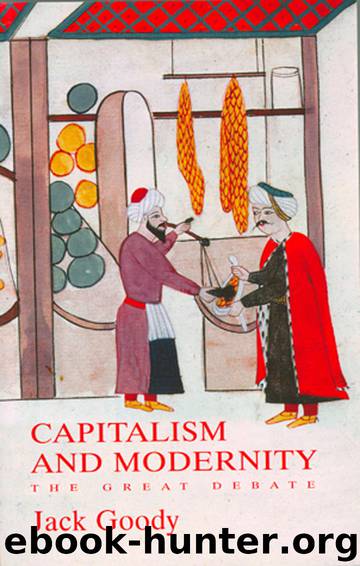Capitalism and Modernity by Goody Jack;

Author:Goody, Jack;
Language: eng
Format: epub
Publisher: Polity Press
Published: 2011-04-27T16:00:00+00:00
5
The Challenge of China
The most effective critique of Eurocentric history has come not so much from the ‘monetary’ historians of the West whom I have discussed but from those historians who have specialized in China. As we have seen, many comparative historians from the West are, unlike those discussed in chapter 1, prepared to grant China’s advance or at least equality before the Renaissance in Europe. But some historians of China itself see the advance as persisting long after that period. Francesca Bray’s thesis about the Ming dynasty (1368–1644), based on an analysis of its technology in the widest sense of the word, is that, despite widespread beliefs, there was no stagnation at that time, which was marked by significant innovations, although these charted a different course than did those of Western industrialization. The commercial and manufacturing economy expanded, but it ‘was stably based on household-level production’, and it was at this level, rather than through new inventions, that considerable improvements in techniques and machinery were made.1 Labour productivity and growth of output took place and China maintained her economic superiority in the world, Bray claims, until industrialization took over in Europe, that is, until the last quarter of the eighteenth century.
China too had its own not only proto-industrial but industrial forms of production, especially in ceramics, which constituted such a large part of her export trade, in bronze, but later on also in cotton. Silk too was produced mainly by women in the household; it was collected for taxation and used for export, but in the Ming period weaving workshops developed in towns where men took over the production. However, the production of tea, also an export crop, remained at a household level, quite unlike its plantation production in Taiwan, India and Ceylon under the British.
China is recognized as passing through ‘an age of astonishing creativity and transformation’2 during the Song (960–1279) and the Yuan (1279–1368) dynasties, and elsewhere too the period 1000–1500 CE witnessed ‘an economic revolution such as the world had never seen’. Cities grew, mainly in the south-east, agriculture was transformed, commerce flourished. Gunpowder, the magnetic compass, and printing – the three inventions that Francis Bacon named in 1605 as the foundation of the modern order in Europe – had all come into common use in China in Song times. Of course Islamic and Chinese sciences suffered set-backs, for example, as the result of the Mongol invasions, equivalent in a way to the fall of Rome that, according to Landes, ‘set European science back almost a thousand years’.3 Subsequently, during the Ming dynasty the country is often thought to have gone through a period of stagnation, when China lost its pre-eminent position in technical enterprise and material expertise, to be overtaken by the West. Mark Elvin’s concept of the ‘high-level equilibrium trap’ was elaborated precisely to explain this stagnation (in inventions) during the Ming.4 He sees Chinese society as having reached an advanced stage but then becoming a prisoner of this level of attainment, which prevented it from further development.
Download
This site does not store any files on its server. We only index and link to content provided by other sites. Please contact the content providers to delete copyright contents if any and email us, we'll remove relevant links or contents immediately.
The Secret History by Donna Tartt(16621)
The Social Justice Warrior Handbook by Lisa De Pasquale(11489)
Thirteen Reasons Why by Jay Asher(7788)
This Is How You Lose Her by Junot Diaz(5769)
Weapons of Math Destruction by Cathy O'Neil(5036)
Zero to One by Peter Thiel(4824)
The Myth of the Strong Leader by Archie Brown(4789)
Promise Me, Dad by Joe Biden(4447)
Beartown by Fredrik Backman(4415)
Stone's Rules by Roger Stone(4415)
How Democracies Die by Steven Levitsky & Daniel Ziblatt(4398)
The Fire Next Time by James Baldwin(4342)
100 Deadly Skills by Clint Emerson(4076)
A Higher Loyalty: Truth, Lies, and Leadership by James Comey(4032)
Rise and Kill First by Ronen Bergman(4012)
The David Icke Guide to the Global Conspiracy (and how to end it) by David Icke(3881)
The Farm by Tom Rob Smith(3872)
Secrecy World by Jake Bernstein(3782)
The Doomsday Machine by Daniel Ellsberg(3730)
